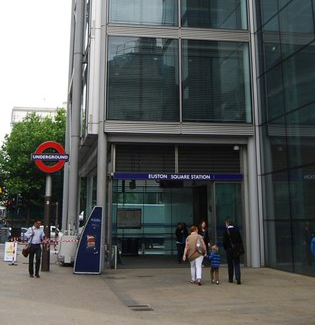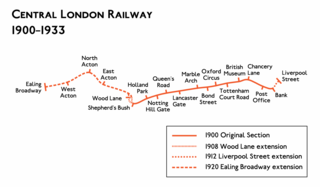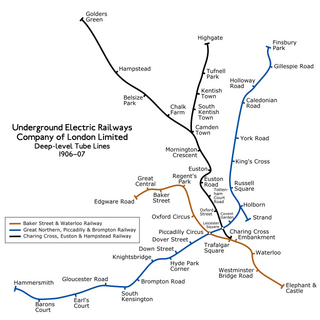Notes and references
Notes
- ↑ Today's London Underground is an amalgamation of a number of separate railway companies that were brought together under the common ownership of the London Passenger Transport Board (LPTB) in 1933. The current operator, Transport for London, is the latest successor of the LPTB.
- ↑ In addition to the stations listed, which received parliamentary approval, there have been many unapproved proposals for new underground railways and unapproved alternative plans for underground railways already opened. The unapproved stations included in such proposals are too numerous to list.
Related Research Articles

The Central line is a London Underground line that runs through central London, from Epping, Essex, in the north-east to Ealing Broadway and West Ruislip in west London. Printed in red on the Tube map, the line serves 49 stations over 46 miles (74 km), making it the longest line on the Underground. It is one of only two lines on the Underground network to cross the Greater London boundary, the other being the Metropolitan line. One of London's deep-level railways, Central line trains are smaller than those on British main lines.

Charing Cross is a London Underground station at Charing Cross in the City of Westminster. The station is served by the Bakerloo and Northern lines and provides an interchange with Charing Cross mainline station. On the Bakerloo line it is between Embankment and Piccadilly Circus stations and on the Northern line it is between Embankment and Leicester Square stations. The station is in fare zone 1.

Embankment is a London Underground station in the City of Westminster, known by various names during its history. It is served by the Circle, District, Northern and Bakerloo lines. On the Bakerloo line and the Charing Cross branch of the Northern line, the station is between Waterloo and Charing Cross stations; on the Circle and District lines, it is between Westminster and Temple and is in Travelcard Zone 1. The station has two entrances, one on Victoria Embankment and the other on Villiers Street. The station is adjacent to Victoria Embankment Gardens and is close to Charing Cross station, Embankment Pier, Hungerford Bridge, Cleopatra's Needle, the Royal Air Force Memorial, the Savoy Chapel and Savoy Hotel and the Playhouse and New Players Theatres.

Aldwych is a closed station on the London Underground, located in the City of Westminster in Central London. It was opened in 1907 with the name Strand, after the street on which it is located. It was the terminus of the short Piccadilly line branch from Holborn that was a relic of the merger of two railway schemes. The station building is close to the Strand's junction with Surrey Street, near Aldwych. During its lifetime, the branch was the subject of a number of unrealised extension proposals that would have seen the tunnels through the station extended southwards, usually to Waterloo.

Holborn is a London Underground station in Holborn, Central London, located at the junction of High Holborn and Kingsway. It is served by the Central and Piccadilly lines. On the Central line the station is between Tottenham Court Road and Chancery Lane stations; on the Piccadilly line it is between Covent Garden and Russell Square and is in Travelcard Zone 1. Close by are the British Museum, Lincoln's Inn Fields, Red Lion Square, Bloomsbury Square, London School of Economics and Sir John Soane's Museum.

Oxford Circus is a London Underground station serving Oxford Circus at the junction of Regent Street and Oxford Street, with entrances on all four corners of the intersection. The station is an interchange between the Bakerloo, Central and Victoria lines. As of 2022, it was the fourth-busiest station on the London Underground. On the Central line it is between Bond Street and Tottenham Court Road, on the Bakerloo line it is between Regent's Park and Piccadilly Circus, and on the Victoria line it is between Green Park and Warren Street. The station is in Travelcard Zone 1.

Green Park is a London Underground station located on the edge of Green Park, with entrances on both sides of Piccadilly. It is served by the Jubilee, Piccadilly and Victoria lines. On the Jubilee line it is between Bond Street and Westminster; on the Piccadilly line it is between Piccadilly Circus and Hyde Park Corner and on the Victoria line it is between Victoria and Oxford Circus. It is in fare zone 1.

East Finchley is a London Underground station in East Finchley in the London Borough of Barnet, north London. The station is on the High Barnet branch of the Northern line, between Finchley Central and Highgate stations, and is in Travelcard Zone 3.

Highgate is a London Underground station and former railway station in Archway Road, in the London Borough of Haringey in north London. The station takes its name from nearby Highgate Village. It is on the High Barnet branch of the Northern line, between East Finchley and Archway stations, and is in Travelcard Zone 3.

Blake Hall is a disused former station on the London Underground in the civil parish of Stanford Rivers, and south from the village of Bobbingworth in Essex. It was latterly on the Central line, between North Weald and Ongar, but was originally served by the Epping to Ongar shuttle service branch line.

Euston is a London Underground station. It directly connects with Euston main line station above it. The station is in Travelcard Zone 1.

Euston Square is a London Underground station at the corner of Euston Road and Gower Street, just north of University College London – its main (south) entrance faces the tower of University College Hospital. The multi-interchange Euston station is beyond Euston Square Gardens, which is one street east. The station is between Great Portland Street and King's Cross St Pancras on the Circle, Hammersmith & City and Metropolitan lines in Travelcard Zone 1.

Finchley Central is a London Underground station in the Church End area of Finchley, north London. The station is located on the High Barnet branch of the Northern line, between West Finchley and East Finchley stations; it is the junction for the short branch to Mill Hill East. The station is around 7 miles north-northwest of Charing Cross and is in Travelcard Zone 4.

The Central London Railway (CLR), also known as the Twopenny Tube, was a deep-level, underground "tube" railway that opened in London in 1900. The CLR's tunnels and stations form the central section of the London Underground's Central line.

The history of the London Underground began in the 19th century with the construction of the Metropolitan Railway, the world's first underground railway. The Metropolitan Railway, which opened in 1863 using gas-lit wooden carriages hauled by steam locomotives, worked with the District Railway to complete London's Circle line in 1884. Both railways expanded, the Metropolitan eventually extending as far as Verney Junction in Buckinghamshire, more than 50 miles (80 km) from Baker Street and the centre of London. The first deep-level tube line, the City and South London Railway, opened in 1890 with electric trains. This was followed by the Waterloo & City Railway in 1898, the Central London Railway in 1900, and the Great Northern and City Railway in 1904. The Underground Electric Railways Company of London (UERL) was established in 1902 to fund the electrification of the District Railway and to complete and operate three tube lines, the Baker Street and Waterloo Railway, the Charing Cross, Euston and Hampstead Railway and the Great Northern, Piccadilly and Brompton Railway, which opened in 1906–07. By 1907 the District and Metropolitan Railways had electrified the underground sections of their lines.

Muswell Hill railway station was in Muswell Hill in North London, just north of the junction of Muswell Hill and Muswell Hill Place. Nothing remains of the station and Muswell Hill Primary School now occupies its former site. In the 1930s, plans were made to electrify the line and transfer the mainline service to London Underground's Northern line, but these were abandoned after the Second World War. The station closed for passengers in 1954 and goods in 1956.

Cranley Gardens railway station was a station in the Muswell Hill area of north London. It was located between Highgate and Muswell Hill stations, at the junction of Muswell Hill Road and Cranley Gardens. Nothing remains of the station today and its site is now occupied by housing and a school. In the 1930s, plans were made to electrify the line and transfer the mainline service to London Underground's Northern line, but these were abandoned after the Second World War. The station closed for passengers in 1954 and for goods in 1957.
The transport system now known as the London Underground began in 1863 with the Metropolitan Railway, the world's first underground railway. Over the next forty years, the early sub-surface lines reached out from the urban centre of the capital into the surrounding rural margins, leading to the development of new commuter suburbs. At the turn of the nineteenth century, new technology—including electric locomotives and improvements to the tunnelling shield—enabled new companies to construct a series of "tube" lines deeper underground. Initially rivals, the tube railway companies began to co-operate in advertising and through shared branding, eventually consolidating under the single ownership of the Underground Electric Railways Company of London (UERL), with lines stretching across London.

The Underground Electric Railways Company of London Limited (UERL), known operationally as the Underground for much of its existence, was established in 1902. It was the holding company for the three deep-level "tube" underground railway lines opened in London during 1906 and 1907: the Baker Street and Waterloo Railway, the Charing Cross, Euston and Hampstead Railway and the Great Northern, Piccadilly and Brompton Railway. It was also the parent company from 1902 of the District Railway, which it electrified between 1903 and 1905. The UERL is a precursor of today's London Underground; its three tube lines form the central sections of today's Bakerloo, Northern and Piccadilly lines.
References
- ↑ "London Underground Film Office". Transport for London. Archived from the original on 3 August 2010. Retrieved 15 July 2010.
- ↑ "New Tickets Released for Hidden London tours". London Transport Museum. Retrieved 15 February 2023.
- 1 2 3 4 Rose 2005.
- ↑ Connor 2001, pp. 104–05.
- ↑ Connor 2001, pp. 100–101.
- 1 2 3 4 Day & Reed 2008, p. 161.
- 1 2 Bruce & Croome 2006, p. 72.
- 1 2 3 4 5 6 7 8 9 Day & Reed 2008, p. 120.
- ↑ Connor 2001, p. 42.
- ↑ Connor 2001, p. 49.
- 1 2 3 4 5 Horne 2001, pp. 72–73.
- 1 2 3 4 5 6 7 8 Horne 2006, p. 23.
- ↑ Connor 2001, p. 103.
- ↑ Connor 2001, pp. 20–21.
- ↑ Connor 2001, pp. 31–32.
- 1 2 Day & Reed 2008, p. 177.
- ↑ Connor 2001, p. 108.
- ↑ "Hammersmith (Grove Road) railway station". Disused Stations. Retrieved 22 May 2010.
- ↑ Connor 2001, p. 109.
- ↑ Connor 2001, p. 19.
- ↑ Connor 2001, p. 112.
- ↑ Connor 2001, pp. 9–10.
- 1 2 3 Day & Reed 2008, p. 135.
- ↑ Connor 2001, p. 69.
- ↑ Connor 2001, p. 121.
- ↑ Connor 2001, p. 71.
- ↑ Connor 2001, p. 115.
- ↑ Day & Reed 2008, p. 202.
- ↑ Connor 2001, p. 53.
- ↑ Connor 2001, p. 26.
- 1 2 Connor 2001, p. 117.
- ↑ Connor 2001, p. 58.
- ↑ "East London line facts". Transport for London. Archived from the original on 6 February 2010. Retrieved 14 July 2010.
- ↑ "Shoreditch". Abandoned tube stations. Retrieved 22 May 2010.
- ↑ Connor 2001, p. 91.
- ↑ Connor 2001, p. 22.
- ↑ Connor 2001, p. 77.
- ↑ Connor 2001, p. 119.
- ↑ Connor 2001, p. 61.
- ↑ "Uxbridge Road". Disused Stations. Retrieved 22 May 2010.
- ↑ Connor 2001, p. 93.
- ↑ Connor 2001, p. 86.
- ↑ Connor 2001, p. 36.
- 1 2 3 4 5 6 7 Horne 2000, p. 36.
- 1 2 3 4 5 6 7 8 9 10 11 12 13 14 Horne 2000, p. 56.
- 1 2 3 4 5 6 7 Day & Reed 2008, p. 118.
- 1 2 3 4 5 6 7 "Alexandra Palace". Disused Stations. Retrieved 13 June 2010.
- 1 2 3 4 5 6 7 8 Horne 2000, p. 52.
- 1 2 3 4 5 Badsey-Ellis 2005, pp. 74–76.
- 1 2 3 4 5 Badsey-Ellis 2005, p. 213.
- 1 2 3 Beard 2002, p. 31.
- ↑ Beard 2002, p. 127.
- 1 2 3 4 5 6 7 Badsey-Ellis 2005, pp. 79–80.
- 1 2 3 4 5 6 7 8 Badsey-Ellis 2005, p. 266.
- 1 2 Beard 2002, p. 124.
- 1 2 Horne 2001, p. 40.
- 1 2 Horne 2001, p. 57.
- 1 2 3 4 5 6 7 Wilson 2008, p. 10.
- 1 2 3 4 5 6 7 Jackson 1966, pp. 676–677.
- 1 2 3 4 Badsey-Ellis 2005, p. 11.
- 1 2 3 4 Badsey-Ellis 2005, p. 13.
- 1 2 Badsey-Ellis 2005, pp. 70–71.
- ↑ Badsey-Ellis 2005, p. 220.
- 1 2 Jackson 1986, p. 130.
- 1 2 Bruce & Croome 2006, p. 38.
- 1 2 Bruce & Croome 2006, pp. 59–60.
- 1 2 3 4 5 6 7 8 9 10 Badsey-Ellis 2005, pp. 273–274.
- ↑ Jackson 1986, p. 41.
- 1 2 3 Jackson 1986, p. 374.
- 1 2 Bruce & Croome 2006, p. 30.
- 1 2 3 Badsey-Ellis 2005, p. 77.
- 1 2 3 Badsey-Ellis 2005, p. 138.
- 1 2 Badsey-Ellis 2005, p. 264.
- ↑ Badsey-Ellis 2005, p. 139.
- ↑ Badsey-Ellis 2005, p. 279.
- 1 2 Connor 2001, p. 14.
- 1 2 Badsey-Ellis 2005, p. 17.
- 1 2 Badsey-Ellis 2005, p. 18.
- ↑ Horne 2005, pp. 22 & 26.
- ↑ Horne 2005, p. 26.
- 1 2 Connor 2001, p. 99.
- ↑ Goudie & Stuckey 1990.
Bibliography
- Badsey-Ellis, Antony (2005). London's Lost Tube Schemes. Capital Transport. ISBN 1-85414-293-3.
- Beard, Tony (2002). By Tube Beyond Edgware. Capital Transport. ISBN 1-85414-246-1.
- Bruce, J Graeme; Croome, Desmond F (2006) [1996]. The Central Line: An Illustrated History. Capital Transport. ISBN 1-85414-297-6.
- Connor, J. E. (2001). London's Disused Underground Stations (2nd ed.). Capital Transport. ISBN 1-85414-250-X.
- Day, John R; Reed, John (2008) [1963]. The Story of London's Underground. Capital Transport. ISBN 1-85414-316-6.
- Goudie, F. W.; Stuckey, Douglas (1990). West of Watford : L.N.W.R., L.M.S., Metropolitan, L.N.E.R., Bakerloo, Watford, Croxley Green, Rickmansworth. Bracknell: Forge Books. ISBN 978-090466218-4.
- Horne, Mike (2000). The Jubilee Line: An Illustrated History. Capital Transport. ISBN 1-85414-220-8.
- Horne, Mike (2001). The Bakerloo Line: An Illustrated History. Capital Transport. ISBN 1-85414-248-8.
- Horne, Mike (2005). The Victoria Line: An Illustrated History. Capital Transport. ISBN 1-85414-292-5.
- Horne, Mike (2006). The District Line: An Illustrated History. Capital Transport. ISBN 1-85414-281-X.
- Jackson, Alan A. (December 1966). "The Wimbledon & Sutton Railway – A late arrival on the South London suburban scene" (PDF). The Railway Magazine. pp. 675–680. Retrieved 4 June 2017.
- Jackson, Alan (1986). London's Metropolitan Railway. David & Charles. ISBN 0-7153-8839-8.
- Leboff, David; Demuth, Tim (1999). No Need To Ask. Harrow Weald: Capital Transport. ISBN 185414-215-1.
- Rose, Douglas (2005). The London Underground: A Diagrammatic History. Capital Transport. ISBN 1-85414-219-4.
- Wilson, Geoffrey (September 2008). "The Wimbledon & Sutton Railway" (PDF). Merton Historical Society: Bulletin 167: 10–13. Retrieved 1 October 2017.
